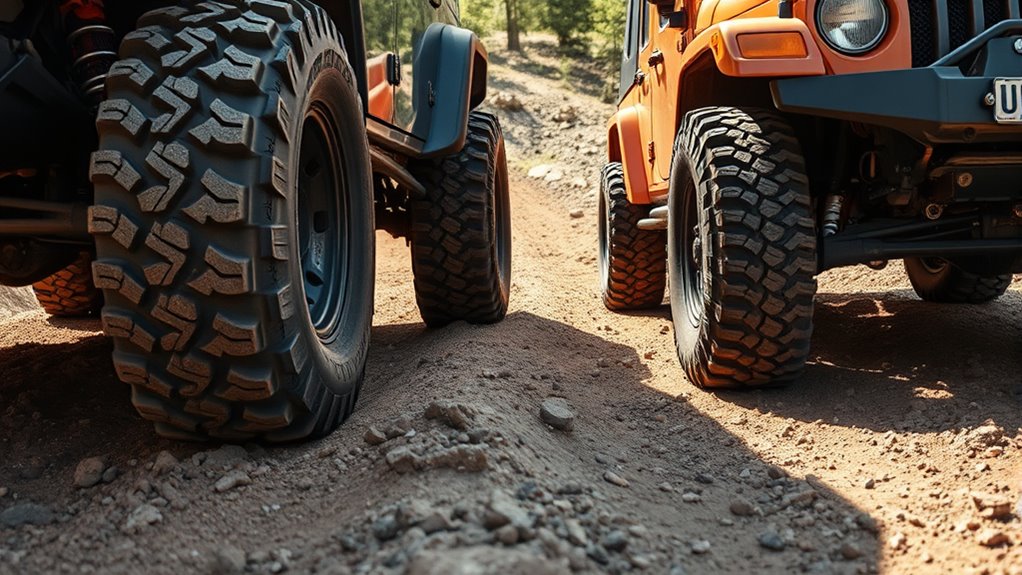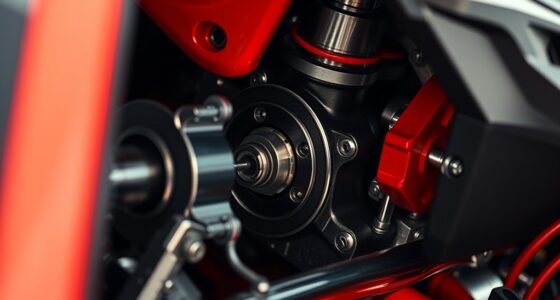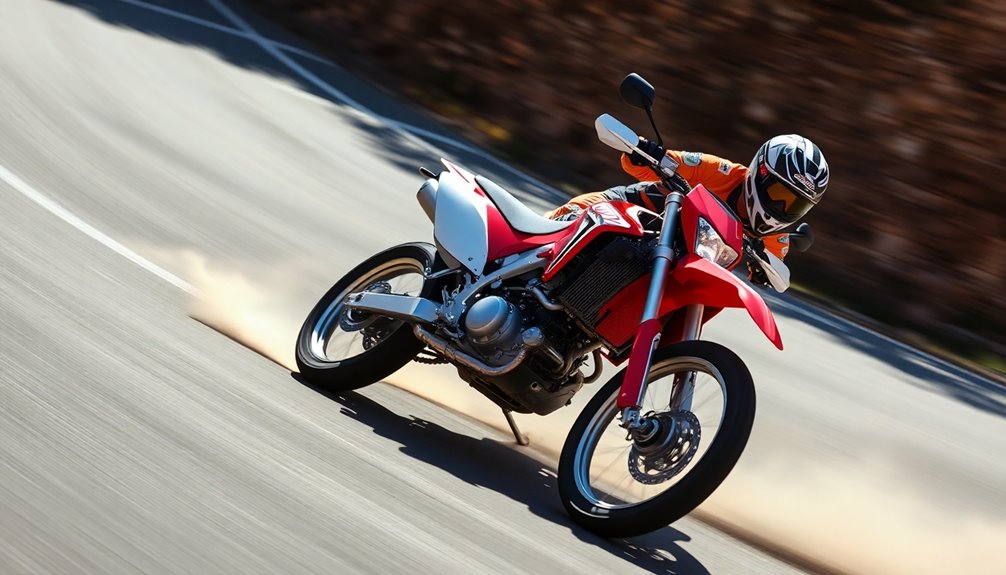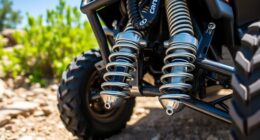Larger tires boost ground clearance and traction, helping you navigate rough terrain more easily. However, they also affect your off-road top speed by increasing rotational mass and altering gear ratios, which can slow you down and impact acceleration. Bigger tires may make handling more challenging, especially during sharp turns. To optimize your off-road performance and speed, considering proper gear adjustments and tire choices is key—stay tuned for more tips.
Key Takeaways
- Larger tires increase ground clearance and obstacle clearance, enhancing off-road top speed on rough terrain.
- Bigger tires provide a larger contact patch, improving traction but potentially reducing overall speed due to increased rolling resistance.
- Increasing tire size may require gear ratio adjustments to maintain optimal off-road top speed.
- Larger tires can make handling less responsive, influencing the ability to navigate tight or technical trails at high speeds.
- Proper tire selection balances grip and clearance, maximizing off-road speed without compromising vehicle stability.
The Basics of Tire Dimensions and Off-Road Performance
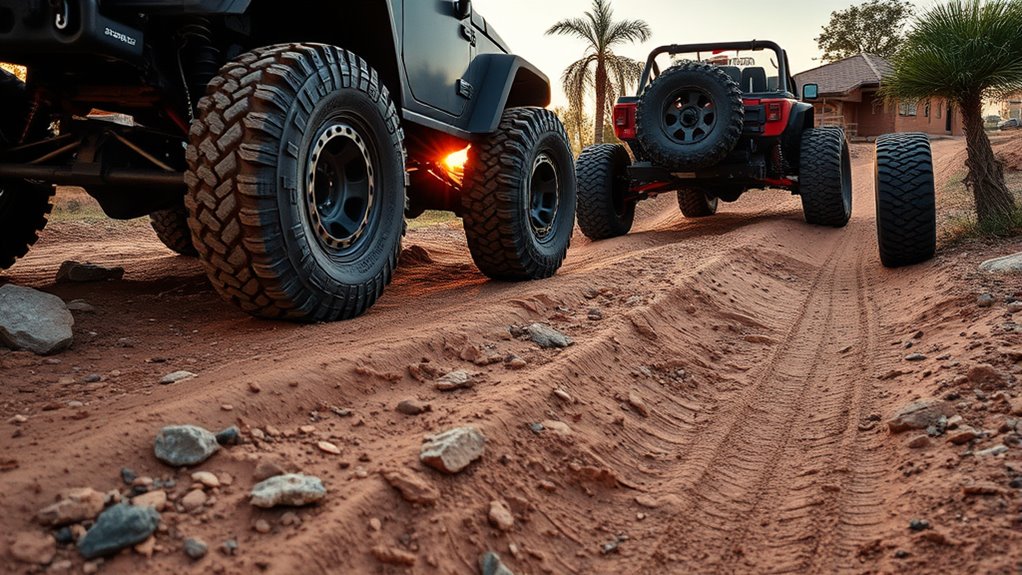
Understanding tire dimensions is essential for optimizing off-road performance. When you select the right tires, you consider the overall diameter, width, and aspect ratio. The diameter impacts ground clearance and rollover stability, while width affects traction and mud-shedding ability. The aspect ratio, which is the height of the sidewall relative to the tire’s width, influences ride comfort and durability. Larger tires typically provide better obstacle clearance and grip on uneven terrain but can also add weight and affect your vehicle’s responsiveness. Precise measurements guarantee you choose tires that suit your driving style and terrain type. Additionally, staying informed about market trends can help you select tires that are popular and proven to perform well. By understanding these basics, you can make informed decisions that enhance your off-road adventures without sacrificing control or safety.
How Larger Tires Impact Vehicle Speed and Maneuverability
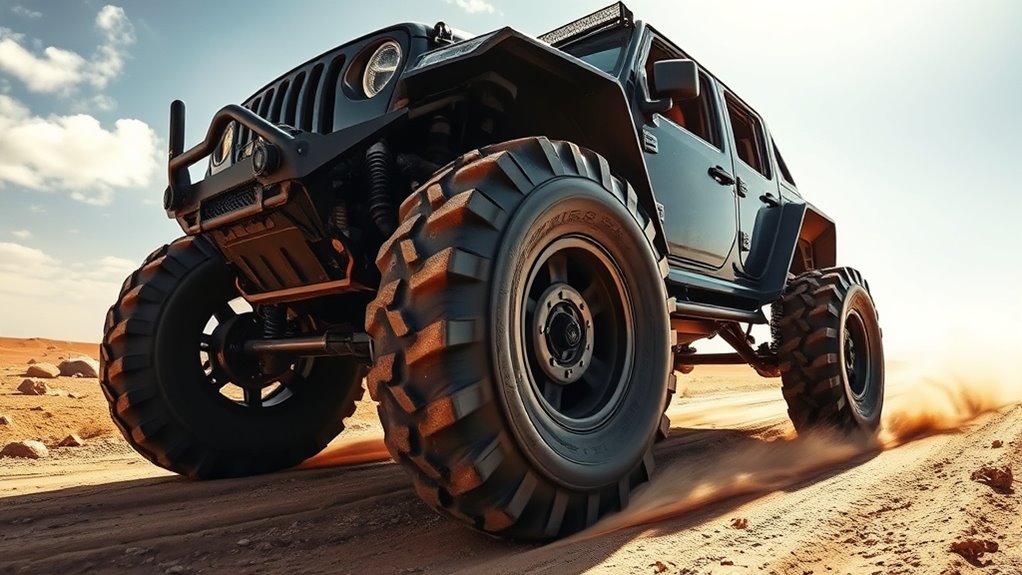
Larger tires can substantially influence your vehicle’s speed and how easily it maneuvers through challenging terrain. With bigger tires, your vehicle gains increased ground contact, which can improve traction but may reduce acceleration. The larger size also means your speedometer reads lower than your actual speed, potentially causing you to underestimate your pace. Maneuverability can become more challenging because bigger tires add weight and change your vehicle’s handling dynamics, making sharp turns or quick adjustments harder. On rough terrain, larger tires help clear obstacles more easily, but they may also cause your suspension to work harder. Additionally, larger tires can affect the overall vehicle balance, impacting stability at higher speeds. Overall, while larger tires boost off-road capability, they can compromise agility and acceleration, requiring you to adapt your driving style accordingly.
The Role of Smaller Tires in Accelerating and Top Speed
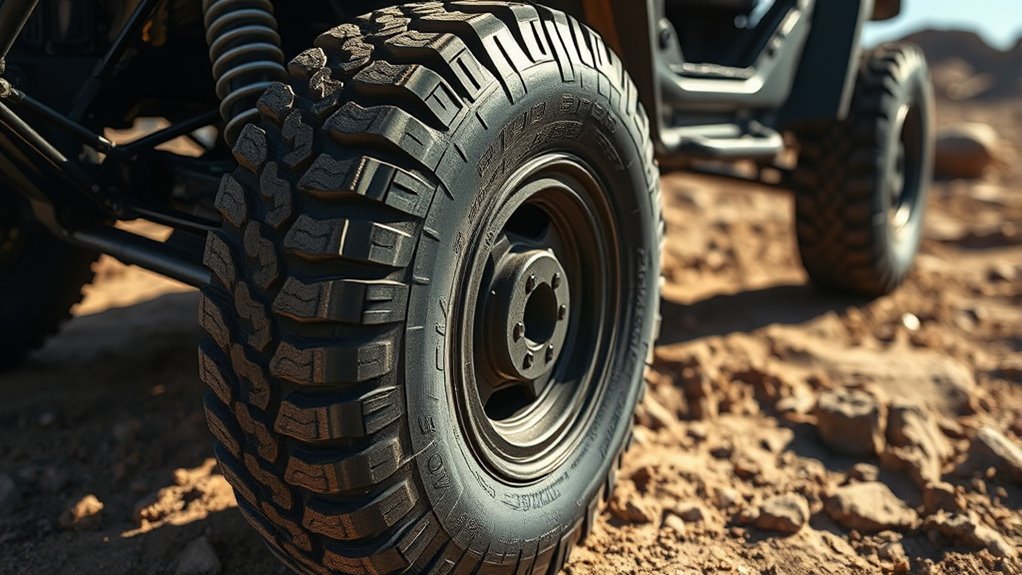
Smaller tires can enhance your vehicle’s acceleration and top speed by reducing rotational mass and rolling resistance. With less weight spinning, your engine doesn’t have to work as hard to turn the tires, resulting in quicker acceleration. Additionally, smaller tires typically have less contact area, which decreases rolling resistance and allows your vehicle to reach higher speeds more efficiently. This improvement in performance can be especially noticeable on smooth or hard-packed surfaces. However, keep in mind that smaller tires may compromise some off-road capabilities like ground clearance and traction. Still, if your goal is to boost acceleration and achieve higher speeds on the trail or road, opting for smaller tires can be a smart choice. Understanding vehicle dynamics is crucial for selecting the right tire size for your needs.
Ground Clearance and Traction: Balancing Off-Road Capabilities
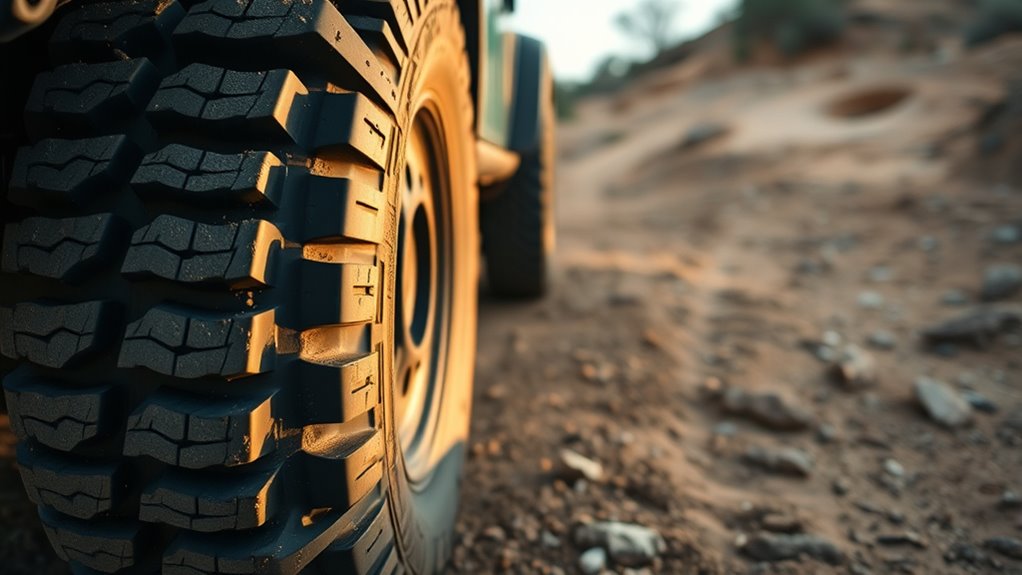
Your tire size directly influences ground clearance and traction, affecting how well your vehicle manages rough terrain. Larger diameters enhance clearance but can diminish grip if the contact patch isn’t optimized. Striking the right balance between lift and grip ensures you maintain control while maximizing off-road performance. Additionally, choosing the appropriate tire size can improve your vehicle’s ability to adapt to various terrains by optimizing off-road capabilities.
Tire Diameter and Clearance
Tire diameter directly influences both ground clearance and traction, which are essential for off-road performance. Larger tires increase your vehicle’s height off the ground, helping you clear obstacles like rocks and logs more easily. This added clearance reduces the risk of getting stuck or damaging your undercarriage. Additionally, bigger tires can improve traction by providing a larger contact patch with uneven terrain, helping you grip surfaces better. Proper tire selection is key to enhancing off-road clearance and overall performance. However, increasing tire diameter also impacts your vehicle’s suspension and steering responsiveness. You may notice a change in handling, and some power loss due to the increased rotational mass. Balancing tire size with your vehicle’s capabilities ensures you get ideal clearance without sacrificing control or efficiency. Using the right eco-friendly materials for your tires can also contribute to more sustainable off-road adventures.
Traction and Contact Patch
Larger tires not only boost ground clearance but also increase the contact patch—the area where your tires meet the terrain. A bigger contact patch improves traction by distributing your vehicle’s weight over a larger surface, reducing slippage on loose or uneven surfaces. This enhanced grip helps you maintain control when climbing hills or guiding tricky terrain. However, the increased patch can also mean more rolling resistance, which might slow you down on flat surfaces. It’s a balancing act: bigger tires improve traction but can compromise speed and fuel efficiency. To get the best off-road performance, you need tires that maximize contact without overly increasing resistance. Properly selecting tire size ensures you get enough grip for challenging terrain while maintaining efficiency for top speed. Tire size choices play a crucial role in balancing off-road capabilities and top speed.
Balancing Lift and Grip
Achieving the right balance between lift and grip is essential for off-road performance. Too much lift reduces ground contact, decreasing traction and control. Conversely, excessive grip can limit ground clearance, making you vulnerable to obstacles. To optimize this balance:
- Adjust tire size to enhance ground clearance without sacrificing contact patch.
- Choose tires with a tread pattern that provides grip without increasing rolling resistance.
- Balance suspension height to maintain stability and prevent top-heaviness.
- Monitor tire pressure to maximize grip while avoiding unnecessary wear or loss of clearance.
- Selecting organic and natural juices from fresh ingredients can also support overall physical resilience and stamina during off-road adventures.
Rotational Mass and Its Effect on Speed and Fuel Efficiency
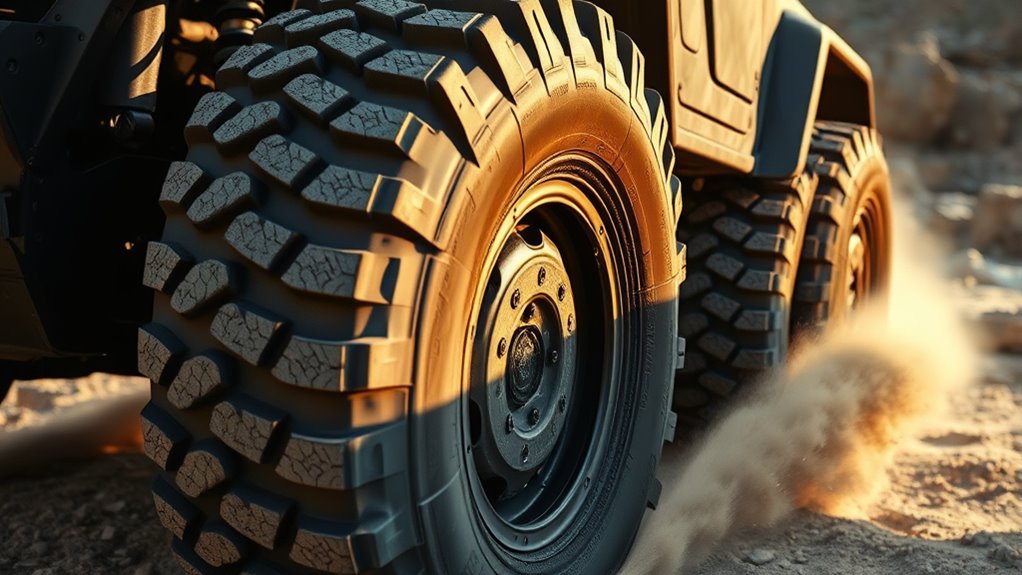
Your vehicle’s rotational mass directly impacts how quickly it accelerates and how much fuel it consumes. Heavier tires or wheels require more effort to spin, reducing top speed and increasing fuel use. Understanding this balance helps you choose the right tire setup for off-road performance without sacrificing efficiency. Additionally, proper maintenance of tires can help optimize performance and fuel economy.
Rotational Mass and Acceleration
Rotational mass markedly impacts both acceleration and fuel efficiency because heavier wheels and tires require more energy to spin up and maintain speed. When you increase rotational mass, your vehicle faces greater resistance during acceleration, meaning it takes longer to reach desired speeds. This additional inertia forces your engine to work harder, reducing responsiveness. To better understand this effect:
- Heavier tires slow initial acceleration, making your vehicle feel sluggish.
- Increased rotational mass causes greater energy drain, lowering fuel economy.
- The extra weight demands more torque from your engine during every start.
- Over time, this added load accelerates wear on drivetrain components.
- Selecting lighter off-road tires can help mitigate some of these performance impacts.
Fuel Consumption Impact
Because heavier tires increase rotational mass, they cause your vehicle to use more fuel to maintain the same speed. The extra weight demands more energy to spin, which means your engine works harder, burning more fuel. Larger tires, especially off-road ones, add significant mass, leading to decreased fuel efficiency. This increased effort also puts more strain on your drivetrain, causing it to wear faster over time. If you’re aiming for better fuel economy, choosing lighter tires can help reduce fuel consumption and improve overall efficiency. Remember, even small weight differences can add up over long drives or tough terrains. So, when selecting tires for your off-road adventures, consider how their weight impacts both your speed and how much fuel you’ll need to keep moving. Proper vehicle maintenance can also help optimize fuel efficiency when using heavier tires.
Tire Diameter vs. Width: Which Matters More for Speed?
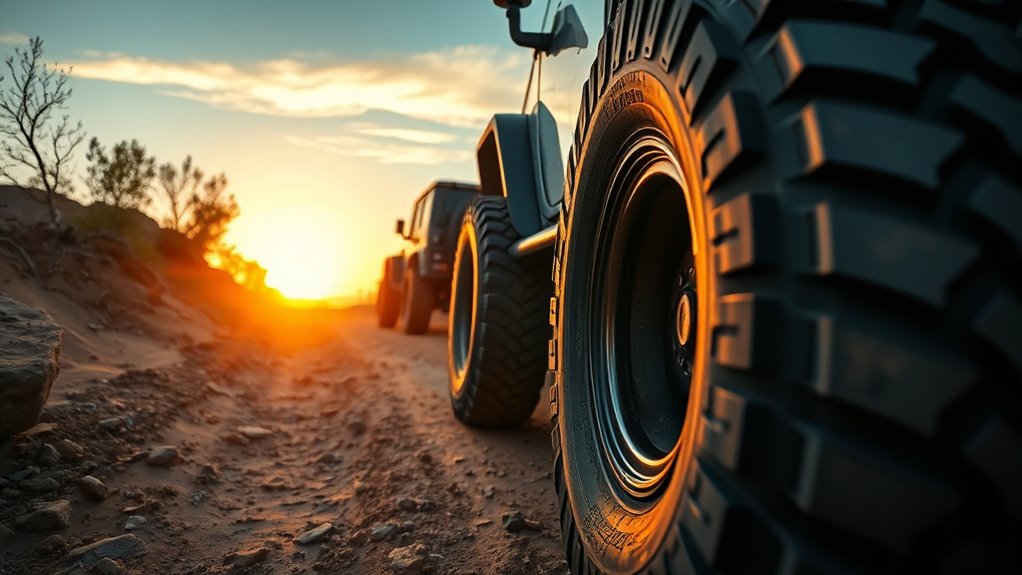
When it comes to off-road top speed, both tire diameter and width influence performance, but understanding which has a greater impact can help you optimize your setup. Generally, tire diameter affects your vehicle’s gearing and overall speed potential more than width. Larger diameters can increase top speed but may reduce acceleration and maneuverability. Conversely, tire width primarily affects traction and stability. To clarify:
- Diameter impacts gear ratios and top speed considerably.
- Width influences grip and handling on uneven terrain.
- Larger diameters may require gear adjustments for ideal performance.
- Wider tires offer better stability but can increase rolling resistance.
Focusing on diameter allows for more straightforward speed gains, while width tweaks fine-tune grip and control. Prioritize diameter if speed is your main goal, but don’t ignore width for traction.
Adjusting Gear Ratios for Different Tire Sizes
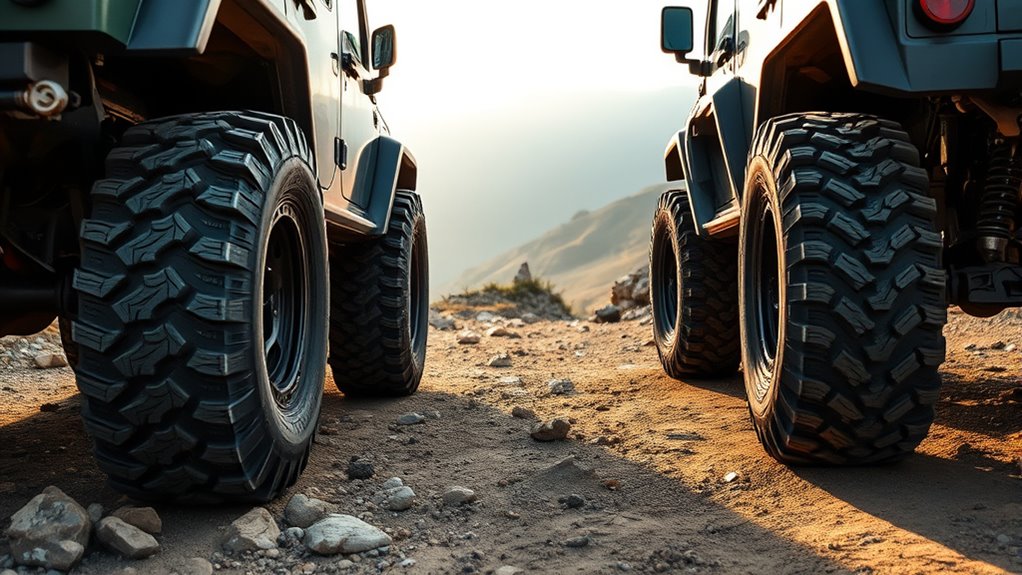
Adjusting gear ratios is essential when changing tire sizes to maintain ideal performance. Larger tires can reduce acceleration and top speed, while smaller tires do the opposite. To compensate, you need to modify your gear ratio accordingly. A higher gear ratio (numerically higher) can help boost torque with larger tires, whereas a lower ratio suits smaller tires for better acceleration. Use the table below as a quick guide:
| Tire Size | Gear Ratio Adjustment | Effect on Speed |
|---|---|---|
| Larger | Increase (higher ratio) | Maintains acceleration, potential top speed loss |
| Smaller | Decrease (lower ratio) | Improves acceleration, reduces top speed |
| Stock | No change | Balanced performance |
| Custom | Adjust based on needs | Fine-tune for specific off-road conditions |
Proper gear adjustment ensures your vehicle performs at its best regardless of tire size.
Potential Challenges When Switching Tire Sizes
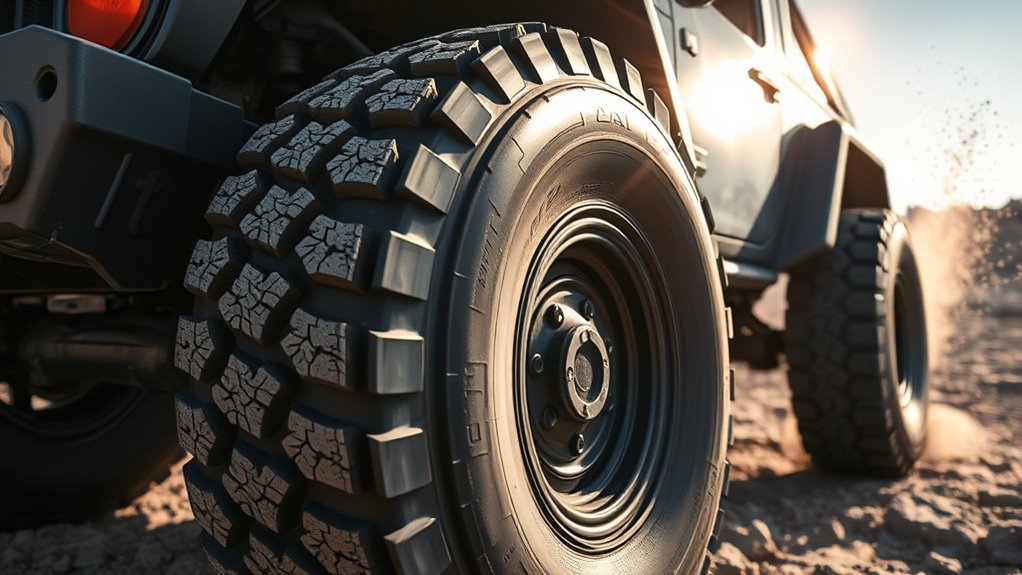
Switching tire sizes can introduce several challenges that impact your vehicle’s performance and safety. First, it can alter speedometer accuracy, leading to misreadings that affect your driving decisions. Second, larger tires may cause increased strain on your drivetrain, risking premature wear or damage. Third, changing tire dimensions can impact suspension geometry, reducing handling and ride quality. Fourth, incompatible tire sizes might interfere with clearance, causing rubbing or obstruction. These issues emphasize the importance of understanding how different tire sizes interact with your vehicle’s systems. Before switching, consider these potential challenges carefully to ensure your off-road adventures remain safe and efficient. Proper planning and adjustments can help you avoid costly repairs and maintain ideal performance.
Making the Right Tire Choice for Your Off-Road Goals
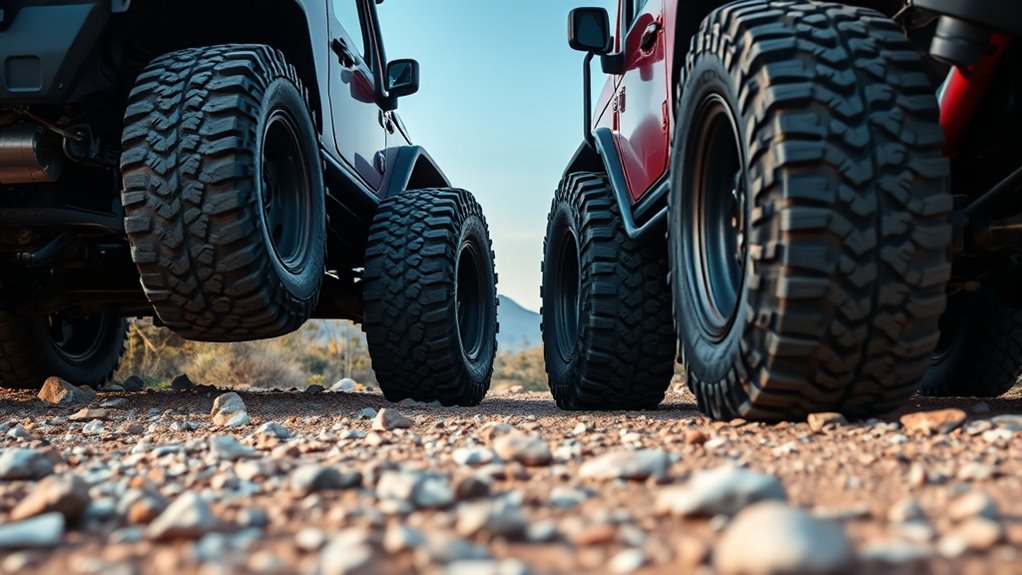
Choosing the right tires for your off-road adventures starts with understanding your specific goals and the terrain you’ll encounter. If you prioritize speed on flat, hard surfaces, opt for tires that reduce rolling resistance and provide a smooth ride. For rocky or uneven terrain, select tires with aggressive tread patterns and reinforced sidewalls to improve traction and durability. Consider tire size carefully; larger tires offer better ground clearance but may decrease top speed. Conversely, smaller tires can enhance acceleration and handling but might limit clearance. Balance your needs by choosing a tire size and type that aligns with your terrain, driving style, and top speed goals. Always consult with experts or test different options to find the perfect fit for your off-road adventures.
Frequently Asked Questions
How Does Tire Size Influence Off-Road Vehicle Stability?
Tire size directly impacts your vehicle’s stability off-road. Larger tires provide a bigger contact patch, helping you maintain grip on uneven terrain. They also improve ride comfort by absorbing shocks better. However, bigger tires can raise your vehicle’s center of gravity, making it more prone to tipping. Smaller tires offer more stability on flat surfaces but might struggle with rough terrain. Choose your tire size based on your off-road needs.
Can Changing Tire Size Void Off-Road Vehicle Warranties?
You might wonder if changing your tire size voids your warranty. It depends on your vehicle’s manufacturer and the modifications made. Usually, if the upgrade causes damage or issues, your warranty could be affected. However, some brands allow certain modifications without voiding coverage. Always check your vehicle’s warranty policy or consult the manufacturer before making any tire size changes to avoid potential disputes.
What Are the Safety Risks of Using Oversized Tires Off-Road?
Using oversized tires off-road is like trying to fit a square peg in a round hole—you risk safety issues. Larger tires can cause your vehicle to handle poorly, increasing the chances of rollovers or losing control on uneven terrain. They may also strain your suspension and steering components, leading to breakdowns. Always consider safety first and make certain your vehicle’s modifications stay within the manufacturer’s guidelines.
How Do Tire Size Changes Affect Vehicle Braking Distances?
When you change tire sizes, it directly impacts your vehicle’s braking distance. Larger tires increase rolling resistance and weight, making it harder to stop quickly. They also alter your speedometer accuracy, which can affect your braking calculations. Smaller tires might reduce braking distance but can compromise traction and stability. Always consider these factors to maintain safe stopping performance when modifying your tires for off-road adventures.
Are There Legal Restrictions on Tire Sizes for Off-Road Vehicles?
You might wonder if there are legal restrictions on off-road tire sizes. Regulations vary by location, but generally, laws focus on safety and environmental impact. Some areas limit tire dimensions to prevent damage or ensure vehicle control, while others have no specific restrictions. Always check local laws before upgrading your tires. Staying compliant helps you avoid fines and guarantees your vehicle remains safe and legal for off-road adventures.
Conclusion
Choosing the right tire size influences your off-road speed, handling, and overall performance. Whether you prioritize top speed, maneuverability, ground clearance, or traction, understanding how tire dimensions affect each aspect helps you make informed decisions. By balancing tire size with gear ratios and considering potential challenges, you can optimize your vehicle’s capabilities. Ultimately, selecting the appropriate tires aligns your off-road goals with your vehicle’s performance, ensuring you get the most from every adventure.
